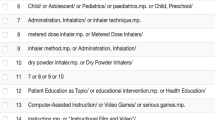Abstract
Objectives
(a) To compare metered dose inhaler (MDI) technique in users with poor English and fluent English, (b) to evaluate two interventions: a translated patient information leaflet (PIL) plus support from an translator (PIL + verbal) and a multimedia touch screen system (MTS) using video clips and own-language instruction.
Methods
(a) Inhaler technique was videotaped and key steps rated blind for 105 fluent English-speakers (FE) and 69 Turkish-speakers with poor English (EP). (b) The EP group was randomised to receive information by MTS (n = 34) or PIL + verbal (n = 35). Inhaler technique was videotaped before and after information.
Main outcome measures
(a) Global inhaler technique; (b) breathing-in time; (c) co-ordination of inspiration and inhaler actuation.
Results
Global technique, co-ordination and breath-holding were all significantly worse in MDI users with poor English. Only 17% of that group had adequate technique compared to over half (62%) of FE. The EP group were significantly less likely than the FE group to report ever seeing the practice nurse about their asthma. After information, global technique was rated as improved in 50% of the MTS group compared to 28% of those given a translated PIL. A further six people (17%) in the PIL group improved after subsequent verbal advice in their own language. Both information methods significantly increased inhaler shaking and mouthpiece checking, but co-ordination only improved in a small number of people.
Conclusions:
The study suggests that Turkish-speaking MDI users with poor English may be disadvantaged in terms of access to medicines information in the UK. The acceptability of pharmacy-based support services for this, and other specific language groups should be explored. Multimedia offers an alternative to a translator for brief explanations, particularly for first-time users, but improving poor co-ordination requires individualised “hands on” teaching from health professionals.
Similar content being viewed by others
References
Directive 2001/83/EC of the European Parliament and of the Council of 6 November 2001 on the Community code relating to medicinal products for human use. Official Journal L 311, 28 November 2001:p20
Shaw J, Hemming MP, Hobson JD, Marty JJ (1977) Comparison of English and non-English speaking outpatients comprehension of medications. Aust J Hosp Pharm 7(3):116–119
Jesson J, Sadler S, Pocock R, Jepson M (1995) Ethnic minority consumers of community pharmaceutical services. Int J Pharm Pract 3:129–132
Paterson LC, Crompton GK (1976) Use of pressurised aerosols by asthmatic patients. BMJ 1:76–77
Hilton S (1990) An audit of inhaler technique among asthma patients of 34 general practitioners. Br J Gen Pract 40:505–506
Nimmo CJ, Chen DN, Martinusen SM, Ustad TL (1993) Assessment of patient acceptance and inhalation technique of a pressurized aerosol inhaler and two breath-actuated devices. Ann Pharmacother 27:922–927
Larsen JS, Hahn M, Ekholm B, Wick KA (1994). Evaluation of conventional press-and-breathe metered-dose inhaler technique in 501 patients. J Asthma 31:193–199
Self TE, Brooks JB, Lieberman P, Ryan MR (1983). The value of demonstration and the role of the pharmacist in teaching the correct use of pressurised bronchodilators. Can Med Assoc J 62:3–21
Dickinson J, Hutton S, Atkin A, Jines K (1992) Reducing asthma morbidity in the community: the effect of a targeted nurse-run asthma clinic in an English general practice. Respir Med 91:634–640
Martys C (1992). Asthma care in Darley Dale: GP audit. BMJ 304:758–760
Gul V, Mackenzie M (1993). Medical counselling and patient compliance in Turkish and Greek-speaking communities in Haringey and Enfield. J R Soc Health 113(6):286–287
Savage I, Goodyer L (2003). Providing information on metered dose inhaler technique: is multimedia as effective as print? Fam Pract 20(5):552–557
Basic Skills Agency benchmark statistics: http://www.bsa.broadshow.net. Accessed 08/04/2003
Gordon M-M, Hampson R, Capell HA, Madhok R (2002) Illiteracy in RA patients as determined by the rapid estimate of adult literacy in medicine (REALM) score. Rheumatology 41:750–754
Raynor DK, Savage I, Knapp P, Henley J (2004) We are the experts: people with asthma talk about their medicine information needs. Patient Educ Couns 53:167–174
Tuffnell DJ, Nuttall K, Raistrick J, Jackson TL (1994) Use of translated written material to communicate with non-English speaking patients. BMJ 309:992
Acknowledgements
The authors would like to thank everyone who took part in the study, or provided facilities and support. The study was funded by the Department of Health, and the North London Primary Care Research Network (Nocten).
Possible conflicts of interest None.
Author information
Authors and Affiliations
Corresponding author
Rights and permissions
About this article
Cite this article
Goodyer, L., Savage, I. & Dikmen, Z. Inhaler technique in Turkish people with poor English: a case of information discrimination?. Pharm World Sci 28, 107–114 (2006). https://doi.org/10.1007/s11096-006-9019-5
Received:
Accepted:
Published:
Issue Date:
DOI: https://doi.org/10.1007/s11096-006-9019-5




